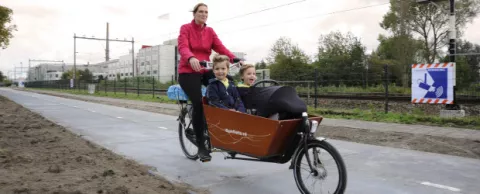
A new bicycle path opened this month in Holland that not only gives bicyclists a safe place to ride, it also generates power for neighboring homes.
It’s one of the most serious experiments yet to see if roads can be a source of energy, something that once seemed like a far-fetched idea. And while that one path isn’t going to illuminate the countryside, it could help shine a light on efforts to think differently about energy production.
Solar-powered bike path
The bicycle path, located in Krommwnie, Holland, is part of a three-year experiment to test the viability of using solar panels as a road surface. The path uses a concrete base topped by crystalline silicon solar cells and a layer of tempered safety glass.
The small path, called SolaRoad, won’t generate much power. The solar cells used in the road produce less than a third of the energy generated by rooftop panels. But the country has more roads than roof space, so the total potential energy that can be generated is much larger. And even with the limited test, the new bicycle path should power two or three homes.
The $3.7 million pilot project also involves more than just testing the potential power. Over the test period, they will be seeing how the surface of the panels hold up to traffic. They will also be testing software and infrastructure to make sure they can add power to the grid when it’s sunny, yet still seamlessly light the homes when it’s dark.
Replacing all pavement with solar panels
Meanwhile in the United States, a company doesn’t want to just cover roads with solar panels; it wants to cover any paved surface. It just raised more than $2 million in a crowdfunding campaign – double what it asked for – to help it cover parking lots with solar panels.
Solar Roadways developed its first prototype solar road surface in 2009, and since then has been working on various pilot projects with the aid of federal grants. It recently wrapped up work on a prototype solar parking lot and plans to use the money it raised through crowdfunding to take that prototype into production.
In addition to the power generation, the company says its solar surface would also keep road surfaces free of snow and ice, and, at least initially, be a huge draw for tourists and shoppers who want to check out the unusual parking lots.
Pedestrians help power their own phones
Solar, however, isn’t the only way to generate power from roads and walkways. A London startup called Pavegen has been turning the kinetic energy from footsteps into power.
One of its first big tests came during the 2012 Summer Olympics in London. It installed its energy collecting floor tiles at the transit center just outside the Olympic Park, generating enough energy to light the center for five hours each night.
Earlier this year, it began installing its technology as part of permanent installations. The first was at a train station in Saint Omer, France, used by 5,000 people each day. The power they generate not only helps light the facility, it also powers cell phone charging stations, drawing new attention to the technology.
In September, it also helped open the first sustainably powered soccer facility in Rio de Janeiro. While some of the electricity comes from solar panels, the soccer pitch is also covered with kinetic energy collectors. As the players run up and down the pitch trying to score, they’re also generating power, lighting the field themselves.
Also of interest…
Europe's first smart solar district intends to clone 'pro-sumers'
The massive efficiency opportunity under your feet (Hint: heat pumps are hot again)
Yes you CAN make your city resilient (here's how)



